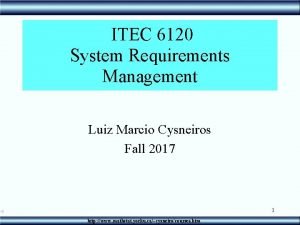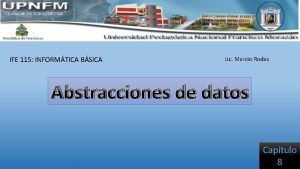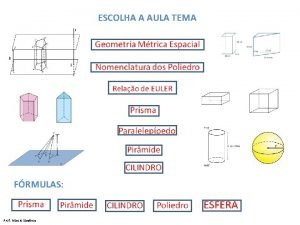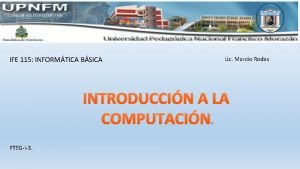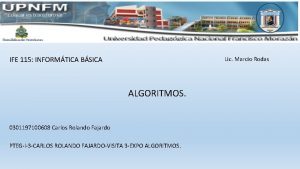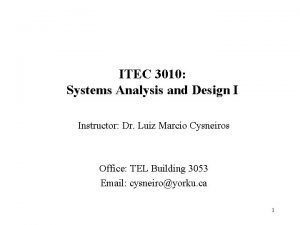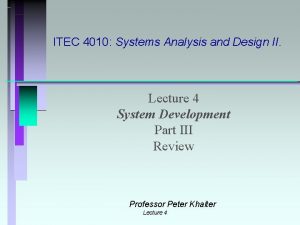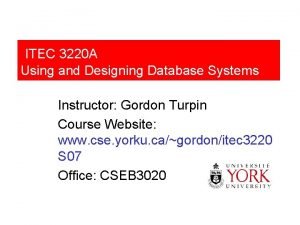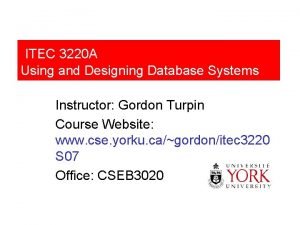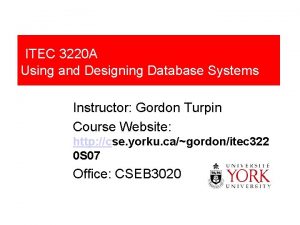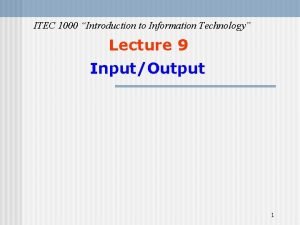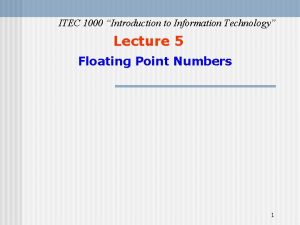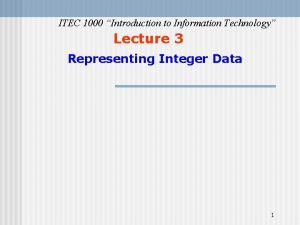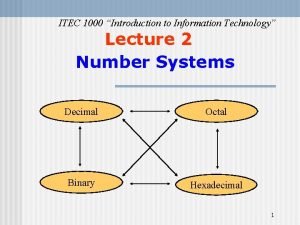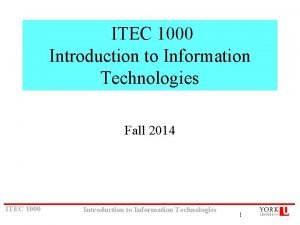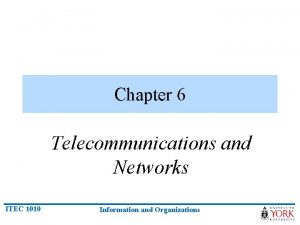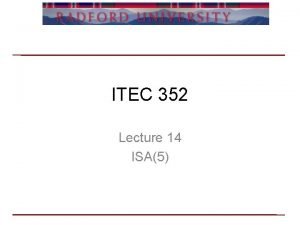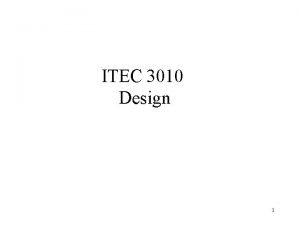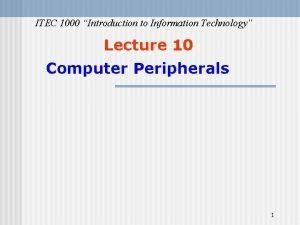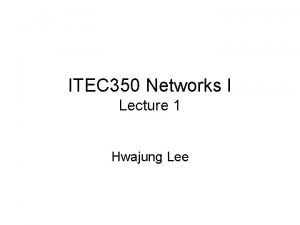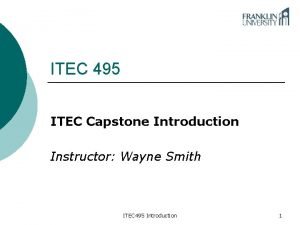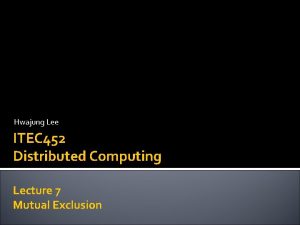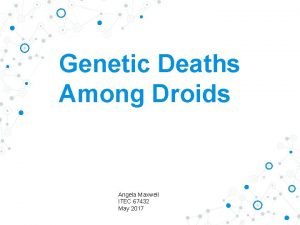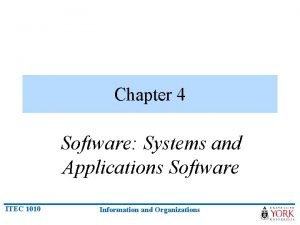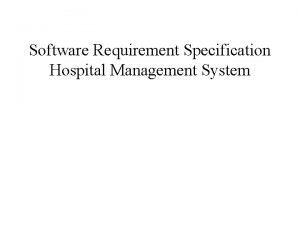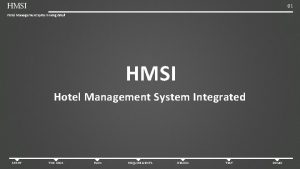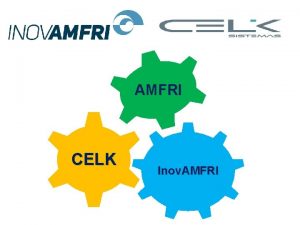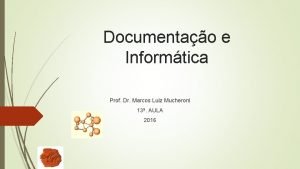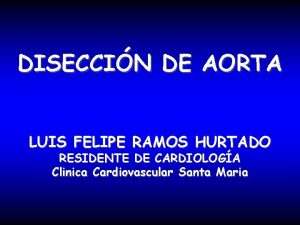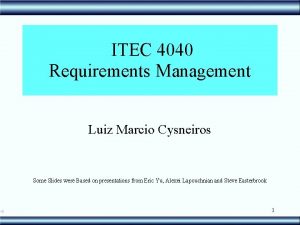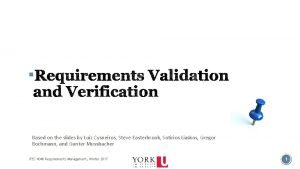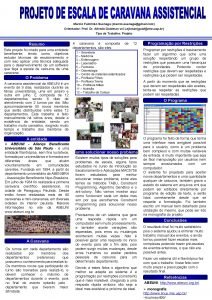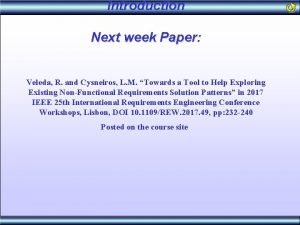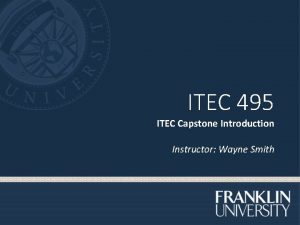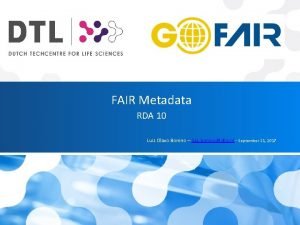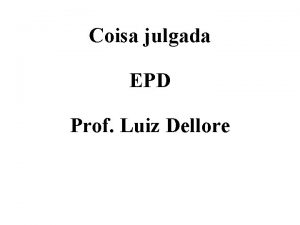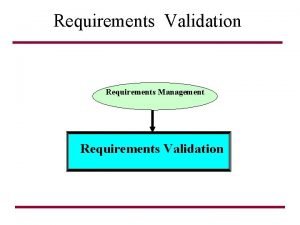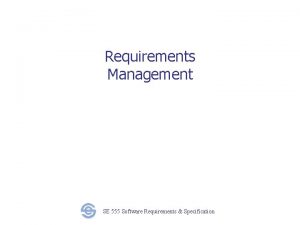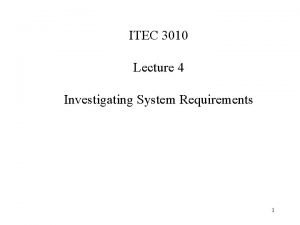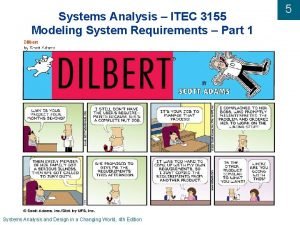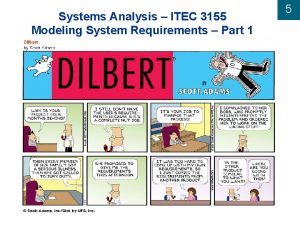ITEC 6120 System Requirements Management Luiz Marcio Cysneiros




















![System: (Macmillan English Dictionary) 1. [count] a set of connected things that work together System: (Macmillan English Dictionary) 1. [count] a set of connected things that work together](https://slidetodoc.com/presentation_image/7087bac9188b06b2475ea76c759b395b/image-21.jpg)














































- Slides: 67

ITEC 6120 System Requirements Management Luiz Marcio Cysneiros Fall 2017 1 http: //www. mathstat. yorku. ca/~cysneiro/courses. htm

http: //www. yorku. ca/cysneiro/courses. htm Textbook Requirements engineering : processes and techniques Gerald Kotonya and Ian Sommerville. Publication info: Chichester ; New York : J. Wiley & Sons, c 1998. ISBN: 0471972088 2 http: //www. mathstat. yorku. ca/~cysneiro/courses. htm

http: //www. yorku. ca/cysneiro/courses. htm Scoring Oral Presentation + Leading discussion 45% Final exam 55% 3 http: //www. mathstat. yorku. ca/~cysneiro/courses. htm

http: //www. yorku. ca/cysneiro/courses. htm Directions email office cysneiro@yorku. ca TEL Building 3053 Office Hours – Tuesday: 2: 30 PM to 3: 30 PM Wednesday 5: 00 PM to 6: 30 PM http: //www. yorku. ca/cysneiro/courses. htm 4 http: //www. mathstat. yorku. ca/~cysneiro/courses. htm

5 http: //www. mathstat. yorku. ca/~cysneiro/courses. htm

6 http: //www. mathstat. yorku. ca/~cysneiro/courses. htm

7 http: //www. mathstat. yorku. ca/~cysneiro/courses. htm

8 http: //www. mathstat. yorku. ca/~cysneiro/courses. htm

Course Objectives • RE State-of-the-art for research and Practice • What does a RE do ? • Techniques • Methods • Process • Understanding RE • Research in RE • Existing Methods • Where it will lead us ? • Alternatives ? 9 http: //www. mathstat. yorku. ca/~cysneiro/courses. htm

The Course at a Glance • • • Introduction Elicitation Modelling Analysis Management Advanced Topics: Goal/Agent-Oriented RE, Social Modelling for RE 10 http: //www. mathstat. yorku. ca/~cysneiro/courses. htm

Nowadays World • Software-Intensive Systems • Software vs Systems ? – Software Alone is useless – Hardware Alone is useless – Both only exist when used to support any human activity – Software+Hardware+People+activities • Systems • Intensive use of software systems 11 http: //www. mathstat. yorku. ca/~cysneiro/courses. htm

Systems/Requirements Analyst • Person who performs systems analysis • Different possible job titles – – – – Systems analyst Business systems analyst Business analyst Process analyst Requirements engineer Requirements analyst Product owner • Role is evolving Systems analyst [WB*] • a specialist who studies the problems and needs of an organization to determine how people, data, processes, and information technology can best accomplish improvements for the business * [WB - Whitten, J. L. , Bentley, L. D. Systems Analysis and Design Methods, 7 th edition, Irwin 12 Mc. Graw-Hill, 2007] http: //www. mathstat. yorku. ca/~cysneiro/courses. htm 12

Skills for a Systems Analyst • • Problem solving Business acumen Domain expertise IT knowledge (IS, various technologies, programming) • Communication – Dealing with business and technical (IT) people – Interviewing, meeting facilitation, etc. – Liaison b/w business and IT 13 http: //www. mathstat. yorku. ca/~cysneiro/courses. htm 13

What is a System? • A system is a group of interrelated components that function together to achieve a desired result [WB] • System [Alter] – Social – no significant use of technology – Sociotechnical – human participants make use of technology – Automated – fully automated once triggered by people, events, etc. • An information system (IS) is an arrangement of people, data, processes, and information technology that interact to collect, process, store, and provide as output the information needed to support an organization [WB] 14 http: //www. mathstat. yorku. ca/~cysneiro/courses. htm 14

More System Definitions • Macmillan English Dictionary – A set of connected things that work together for a particular purpose • A central heating system • I decided to install a security system to prevent any break-ins. • The city’s inadequate public transportation system 15 http: //www. mathstat. yorku. ca/~cysneiro/courses. htm 15

More System Definitions • Ackoff [Russell L. Ackoff. Towards a System of Systems Concepts. Management science, 17(11), 661 -71. 1971] – Set of (at least two) interrelated elements/components – Each element is connected to every other element (directly or indirectly) – No subset of elements is unrelated to any other subset • Weinberg [Gerald M. Weinberg. Introduction to General Systems Thinking, 1975] – “A system is a way of looking at the world” • Systems don’t really exist! • Just a convenient way to describe things (e. g. , just like “sets”) 16 http: //www. mathstat. yorku. ca/~cysneiro/courses. htm 16

Nowadays World • Software systems present opportunities for change – It may be complex but should also be adaptable – Changes very quickly and some times very frequently – A New System may change human activities in many significant ways • • • Paperless Hospitals Virtual Doctors Virtual Surgeries Phone Chat Facebook 17 http: //www. mathstat. yorku. ca/~cysneiro/courses. htm

Nowadays World • Software Systems became Ubiquitous – Even Refrigerators have software systems today – However, we are frequently disappointed with them – If it doesn’t work chances are : • Who designed didn’t understood what was needed • It is been used for different purposes than the original intended 18 http: //www. mathstat. yorku. ca/~cysneiro/courses. htm

19 http: //www. mathstat. yorku. ca/~cysneiro/courses. htm

Requirement: (Macmillan English Dictionary) something that is needed in order for something to happen: 1. – Check the car’s fuel requirements. – Good insulation can cut the energy requirements of a house by more than half. 2. something that a rule, law, contract, etc. states that you must do: – Do these goods comply with our safety requirements? – requirement of: It is usually a requirement of banks and investors that a new company is formed to effect the management buy-out. – requirement for: Applicants must satisfy the requirements for admission to the university. 20 http: //www. mathstat. yorku. ca/~cysneiro/courses. htm
![System Macmillan English Dictionary 1 count a set of connected things that work together System: (Macmillan English Dictionary) 1. [count] a set of connected things that work together](https://slidetodoc.com/presentation_image/7087bac9188b06b2475ea76c759b395b/image-21.jpg)
System: (Macmillan English Dictionary) 1. [count] a set of connected things that work together for a particular purpose: – a central heating system – I decided to install a security system to prevent any break-ins. – the city’s inadequate public transportation system System: some part of a reality that can be observed to interact with its environment a set of interrelated components, or sub-systems, with a particular purpose. 1) there are 2 components at least, 2) each of which is related (directly or indirectly) to every other component and, 3) no sub set of which is unrelated to any other subset. Ackoff, Russell L. , (1971). Towards a System of Systems Concepts. Management science, 17(11), 661 -71. SOFTWARE VS SYSTEMS ? 21 http: //www. mathstat. yorku. ca/~cysneiro/courses. htm

Context • Software crises continues – Denver Airport • More than 50 million US $ due to errors in the baggage control system – London Ambulance Service • The system was deactivated one day after its deployment due to many errors. Most of them related to non-functional requirements such as: Safety, Reliability and Usability 22 http: //www. mathstat. yorku. ca/~cysneiro/courses. htm

Software Crises • Flaws in the Production Process Unhappy Clients High costs 23 http: //www. mathstat. yorku. ca/~cysneiro/courses. htm

Europe • Questionnaire sent to 3. 805 companies showed: • For the Analysts, Major problems are: – Requirements specification (53%) – Requirements Management (43%) – Documentation (36%) – Test (35%) 24 http: //www. mathstat. yorku. ca/~cysneiro/courses. htm

USA • Requirements Management (Also know as Requirements Engineering – RE) is seen as one of the most important problems to be overcome in order for companies to achieve level 2 in the SEI’s (Software Engineering Institute – Carnegie Mellon) CMM (Capability Maturity Model) • SEI has recently released a package aiming to transfer technology in RE to facilitate companies’ certification 25 http: //www. mathstat. yorku. ca/~cysneiro/courses. htm

Good News … “ 26% of the Software projects were considered a success. ” Standish Group, CHAOS Report, 2000 26 http: //www. mathstat. yorku. ca/~cysneiro/courses. htm

Bad News… Meaning that 74% have FAILED! Standish Group, CHAOS Report, 2000 27 http: //www. mathstat. yorku. ca/~cysneiro/courses. htm

Even Worse: • CHAOS Report, 2015. The Standish Group. – “ 29% of the Software projects were considered a success. ” • Almost two-fold increase from 1994! – But this means that 71% were not (fully) successful! 28 http: //www. mathstat. yorku. ca/~cysneiro/courses. htm

CHAOS Reports • Widely cited (since 1994) • Type 1. Project success: completed on -time and on-budget, with all features and functions as initially specified • Type 2. Project challenged: completed and operational but overbudget, over the time estimate, and offers fewer features and functions than originally specified • Type 3. Project impaired: project is canceled at some point during the development cycle 29 http: //www. mathstat. yorku. ca/~cysneiro/courses. htm 29

From the CHAOS Reports 30 http: //www. mathstat. yorku. ca/~cysneiro/courses. htm 30

From the CHAOS Reports 31 http: //www. mathstat. yorku. ca/~cysneiro/courses. htm 31

From the CHAOS Reports 32 http: //www. mathstat. yorku. ca/~cysneiro/courses. htm 32

Tom De Marco “ 56% of the errors in a software can be traced back to the requirements phase” • The later an error is detected the more expensive is to fix it. • Many errors are done during Requirements elicitation and analysis 33 http: //www. mathstat. yorku. ca/~cysneiro/courses. htm

• Many errors in requirements can (and should) be detected early in the software development life cycle. • Typical errors include: Use of incorrect facts, omission, inconsistency and ambiguity. • Errors in requirements specification are one of the major concerns for software industry. 34 http: //www. mathstat. yorku. ca/~cysneiro/courses. htm

200 x Cost to Repair Analysis Design Code Unit Test Integration Maintenance Test Stage when the Error is found 35 http: //www. mathstat. yorku. ca/~cysneiro/courses. htm

Definition of RE “ Requirements engineering is a sub-area of Software Engineering that studies the process of defining the requirements for a software-to-be. It is a new area started in 1993 when the 1 st International Symposium on RE was organized. The process for defining requirements is an interface between the desires and the needs of the clients and a future implementation of these requirements as a software. ” 36 http: //www. mathstat. yorku. ca/~cysneiro/courses. htm

37 http: //www. mathstat. yorku. ca/~cysneiro/courses. htm

Goals • Understand the needs and support the client’s desires. • Provide the Requirements Engineer with methods, techniques and tools to help on the process of understanding and registering what a software must do. 38 http: //www. mathstat. yorku. ca/~cysneiro/courses. htm

Fred Brook’s • Brook adds: “The most difficult part of building a software system is to decide, precisely, what must be built. No other part of the work can undermine so badly the resulting software if not done correctly. No other part is so difficult to fix later. ” 39 http: //www. mathstat. yorku. ca/~cysneiro/courses. htm

Factors influencing requirements • Personality and status of stakeholders • The personal goals of individuals within an organization • The degree of political influence of stakeholders within an organization 40 http: //www. mathstat. yorku. ca/~cysneiro/courses. htm

RE process problems • • • Lack of stakeholder involvement Business needs not considered Lack of requirements management Lack of defined responsibilities Stakeholder communication problems Over-long schedules and poor quality requirements documents • Many confuse it with Design • Pressure from the Market – “It has to be ready next week” • Clients keep adding and changing things 41 http: //www. mathstat. yorku. ca/~cysneiro/courses. htm

Process improvement • Process improvement is concerned with modifying processes in order to meet some improvement objectives • Improvement objectives – Quality improvement – Schedule reduction – Resource reduction 42 http: //www. mathstat. yorku. ca/~cysneiro/courses. htm

Planning process improvement • What are the problems with current processes? • What are the improvement goals? • How can process improvement be introduced to achieve these goals? • How should process improvements be controlled and managed? 43 http: //www. mathstat. yorku. ca/~cysneiro/courses. htm

Process maturity • Process maturity can be thought of as the extent that an organization has defined its processes, actively controls these processes and provides systematic human and computer-based support for them. • The SEI’s Capability Maturity Model is a framework for assessing software process maturity in development organizations 44 http: //www. mathstat. yorku. ca/~cysneiro/courses. htm

Capability maturity model 45 http: //www. mathstat. yorku. ca/~cysneiro/courses. htm

RE process maturity levels • Initial level – No defined RE process. Suffer from requirements problems such as requirements volatility, unsatisfied stakeholders and high rework costs. Dependent on individual skills and experience. • Repeatable level – Defined standards for requirements documents and policies and procedures for requirements management. • Defined level – Defined RE process based on good practices and techniques. Active process improvement process in 46 place. http: //www. mathstat. yorku. ca/~cysneiro/courses. htm

Maturity levels • Managed level – Detailed measurements of both process and product quality are collected and used to control the process. • Optimizing level – The organization has a continuous process improvement strategy, based on objective measurements in place. 47 http: //www. mathstat. yorku. ca/~cysneiro/courses. htm

Good practice for RE process improvement • RE processes can be improved by the systematic introduction of good requirements engineering practice • Each improvement cycle identifies good practice guidelines and works to introduce them in an organization 48 http: //www. mathstat. yorku. ca/~cysneiro/courses. htm

Project Management + Mature Process • Metrics ! A critical tool – If you don’t have metrics you can not manage it – Milestones – People – Productivity – Mistakes – Time to fix mistakes – Etc. 49 http: //www. mathstat. yorku. ca/~cysneiro/courses. htm

2015 50 http: //www. mathstat. yorku. ca/~cysneiro/courses. htm

Why Requirements Engineering? Von Neumann: “There is no sense in being precise when you don’t even know what you are talking about” 51 http: //www. mathstat. yorku. ca/~cysneiro/courses. htm

Context • The Blank Page Fallacy • The Completeness Fallacy • Social Aspects Involved 52 http: //www. mathstat. yorku. ca/~cysneiro/courses. htm

So, What are Requirements? Clients Users Needs Limitations Impossibilities Technological Infra-Structure 53 http: //www. mathstat. yorku. ca/~cysneiro/courses. htm

Definition • Software Requirements – Sentences that express clients’ needs and establish the desired quality 54 http: //www. mathstat. yorku. ca/~cysneiro/courses. htm

Types of Requirements • Functional Requirements – FR are the requirements that are directly related to the software functionality. – What the system must do ! • Non-Functional Requirements – NFRs express constraints that a software must comply with. – Can be seen as specific qualities that a software must have – “How” the software must do the “What” • Ex: Safety, accuracy, usability, security • Requirements-1 (Inverse Requirements) – IR establish conditions that must never happen – Frequently associated to an NFR 55 http: //www. mathstat. yorku. ca/~cysneiro/courses. htm

After all, What are Requirement? Clients FR Users Needs Limitations Impossibilities NFR IR Technological Infra-Structure 56 http: //www. mathstat. yorku. ca/~cysneiro/courses. htm

Examples • The system should provide a form to enter results for clinical tests performed for a client (FR) • Depending on the result of the test, only the Supervisor can entry the result for this patient. E. g. Glucose over 8. 0 (NFR Safety) • The system should give the client a receipt. This should take no longer than 8 sec (FR “. ” NFR Performance) • The system can not erase any client information (IN) 57 http: //www. mathstat. yorku. ca/~cysneiro/courses. htm

Definitions • Universe of Discourse – Is the context in which the software should be developed and operated. Uof. D includes all sources of information and all people related to the software. These people are also known as the actors of this universe. Uof. D is a reality circumstantiated by the set of goals defined by those who demand the software 58 http: //www. mathstat. yorku. ca/~cysneiro/courses. htm

Information Systems Universe of Discourse Macrosystem Software System 59 http: //www. mathstat. yorku. ca/~cysneiro/courses. htm

organization hardware software Information System 60 http: //www. mathstat. yorku. ca/~cysneiro/courses. htm

61 http: //www. mathstat. yorku. ca/~cysneiro/courses. htm

An SADT Model for the Definition of Requirements Uof. D Select Personel Uof. D Soft. Eng. Viewpoints clients Elicit method facts requirements Model model Uof. D Select Method Analyse tools 62 http: //www. mathstat. yorku. ca/~cysneiro/courses. htm

The “Requirements Lifecycle” • Not Waterfall • Not Spiral • Not Iterative 63 http: //www. mathstat. yorku. ca/~cysneiro/courses. htm

64 http: //www. mathstat. yorku. ca/~cysneiro/courses. htm

Books • Requirements Engineering: Processes and Techniques by Ian Sommerville, Gerald Kotonya (September 1998) John Wiley & Son Ltd; ISBN: 0471972088 Amazon. com Sales Rank: 188, 502 • System Requirements Engineering by Pericles Loucopoulos, Vassilios Karakostas (June 1995) Mc. Graw Hill Text; ISBN: 0077078438 Amazon. com Sales Rank: 1, 067, 908 • Software Requirements & Specifications : A Lexicon of Practice, Principles and Prejudices by Michael Jackson (July 1995) Addison-Wesley Pub Co; ISBN: 0201877120 Amazon. com Sales Rank: 38, 607 65 http: //www. mathstat. yorku. ca/~cysneiro/courses. htm

More Books • Exploring Requirements : Quality Before Design by Donald C. Gause and Gerald M. Weinberg (September 1989) Dorset House; ISBN: 0932633137 Amazon. com Sales Rank: 13, 641 • Mastering the Requirements Process by Suzanne Robertson, James Robertson (May 4, 2000) Addison-Wesley Pub Co; ISBN: 0201360462 ; Dimensions (in inches): 0. 93 x 9. 50 x 7. 66 Amazon. com Sales Rank: 7, 392 • Managing Software Requirements: A Unified Approach (The Addison. Wesley Object Technology Series)by Dean Leffingwell, Don Widrig (November 1999), Addison-Wesley Pub Co; ISBN: 0201615932 Dimensions (in Inches): 1. 13 x 9. 46 x 7. 76 Amazon. com Sales Rank: 14, 447 66 http: //www. mathstat. yorku. ca/~cysneiro/courses. htm

Reading for next Class • Requirements Engineering - a roadmap - Nuseibeh, Easterbrook – First Presentation • • [Goguen 94] - Goguen, J. A. and Linde, C. - Techiques for Requirements Elicitation, In Proceedings of the First IEEE International Symposium on Requirements Engineering, San Diego, Ca, IEEE Computer Society Press - 1994, pp 152 -164. • [Goguen 94 a] - Goguen, Joseph - Requirements Engineering as the reconciliation of social and technical issues - in Requirements Engineering: Social and Technical Issues edited by Joseph Goguen and Marina Jirotka - Academic Press 1994. • Download from course page 67 http: //www. mathstat. yorku. ca/~cysneiro/courses. htm
 Luiz marcio cysneiros
Luiz marcio cysneiros Le plus gros bulldozer caterpillar du monde
Le plus gros bulldozer caterpillar du monde Navmed 6120/1
Navmed 6120/1 Marcio janot
Marcio janot Marcio fundo ostia
Marcio fundo ostia Marcio rodas
Marcio rodas V=512cm3
V=512cm3 Marcio rodas
Marcio rodas Marcio rodas
Marcio rodas Márcio bilharinho naves
Márcio bilharinho naves Projet terminale sti2d itec
Projet terminale sti2d itec Ad systems exam slide
Ad systems exam slide Itec 4010
Itec 4010 Itec 3220
Itec 3220 Zona de subduccion
Zona de subduccion Itec 3220
Itec 3220 Itec 3220
Itec 3220 Itec 1000
Itec 1000 Itec 1000
Itec 1000 Itec 1000
Itec 1000 Itec 1000
Itec 1000 Itec 1000
Itec 1000 Itec 1010
Itec 1010 Itec exam results
Itec exam results Itec 3010
Itec 3010 Itec 1000
Itec 1000 Itec irrigation controller
Itec irrigation controller Itec 350
Itec 350 Itec
Itec Itec
Itec Cs itec
Cs itec Itec
Itec Edmodo основатели
Edmodo основатели Qu es
Qu es Itec software
Itec software Hospital management system requirements
Hospital management system requirements Scope of gym management system project
Scope of gym management system project Non functional requirements of hotel management system
Non functional requirements of hotel management system Ricardo luiz menezes da silva
Ricardo luiz menezes da silva Tourinho sai de baixo
Tourinho sai de baixo Antonio carlos seabra
Antonio carlos seabra Assum preto luiz gonzaga
Assum preto luiz gonzaga Cronograma projeto de tese doutorado
Cronograma projeto de tese doutorado Luiz vicente de souza queiroz
Luiz vicente de souza queiroz Luiz felipe em japonês
Luiz felipe em japonês Rodrigo aranha
Rodrigo aranha Celk navegantes
Celk navegantes Desenho de pedro luiz padovini
Desenho de pedro luiz padovini Marcos luiz mucheroni
Marcos luiz mucheroni Luiz pareto
Luiz pareto Marcos luiz mucheroni
Marcos luiz mucheroni Marcos luiz mucheroni
Marcos luiz mucheroni Marcos luiz mucheroni
Marcos luiz mucheroni Bussunda luiz guilherme vianna
Bussunda luiz guilherme vianna Músicas de luiz gonzaga
Músicas de luiz gonzaga Washington luiz ferreira rios
Washington luiz ferreira rios Luiz felipe ramos
Luiz felipe ramos Luiz barsi filho formação
Luiz barsi filho formação Pedro luiz de castro
Pedro luiz de castro Luiz moutinho
Luiz moutinho Marcos luiz mucheroni
Marcos luiz mucheroni Ronir raggio luiz
Ronir raggio luiz Marcelo de oliveira rosa
Marcelo de oliveira rosa Luiz eduardo camanho
Luiz eduardo camanho Fernando luiz pellegrini pessoa
Fernando luiz pellegrini pessoa Luiz di marcello
Luiz di marcello Baiuca
Baiuca A morte dos girassóis caio fernando abreu
A morte dos girassóis caio fernando abreu
